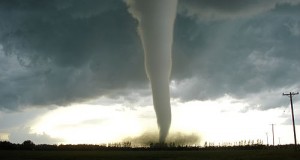When you left the Jeep by the trail, and began heading down the oak leaf-covered footpath that winds its way up the mountain ridge, you felt certain about today’s weather. You had enjoyed a gorgeous night of tenting under the stars and a delicious breakfast, but then it hits you: the realization that the sky seems to be turning darker by the hour.
Before long, you’re getting the distinct impression that you might have just hiked 16 miles into the woods, only to shiver in the rain, and may even be forced to head home in defeat. And then there’s always the possibility that this might just be … well … a bunch of rainless clouds.
This is going to be one tough call to make.
And even if you had brought your smartphone with you, and not left it in the Jeep, it wouldn’t have done much good. There are no smartphone towers around here, and technology isn’t really going to help you in this situation.
Many have suggested that a hiker’s barometer/thermometer watch could provide data on the current situation, but unfortunately, most in the “affordable range” tend not to work effectively. Besides, you’d also have to know how to interpret this data, and it’s not even going to offer near the accuracy that you’d get from two important pieces of gear — items that you had with you all along: your eyes and your brain.
The Survival Water Filter That Fits In Your POCKET!
Your eyes can see the data, and your brain can do a darn good job of interpreting it. So, here are just a few of the basics on reading the clouds for when you have just as much need for a smartphone in the woods today, as just another text from the boss.
Clouds You Should Know
To start off, here’s a quick little guide on how to identify the clouds overhead, along with descriptions on what they mean:
Fair Weather Clouds
Cumulus — Fair weather (unless closely clumped together, which could signal a little rain on the way). They generally look a bit like floating cotton balls.
Cirocumulus — Looks like a very thin high-altitude blanket, most likely to dissipate into clear blue sky. This could also foretell of a massive hurricane-like storm system approaching within days in extreme cases.
Possible Warning Clouds
Cirrus — High-altitude wisps, indicating a possible major weather change and storms within 24-48 hours. Especially pay attention if cirrus clouds appear in a wavy pattern.
Cirrostratus — Cirrus clouds accumulate and thicken, possibly warning of rain or snow on the way.
Altostratus – These create a thick grey veil over the sun, meaning the rain is soon to come.
Storm Clouds
Nimbostratus – Low level thick, wet wisps, meaning it’s probably not going to clear up anytime soon.
Cumulonimbus – These are your thunderstorm clouds. You’d better hunker down and take cover immediately.
Storm Clouds Descend
One important thing to pay attention to is how the weather is progressing. With the exception of certain regions with their own unique weather phenomena, most storm systems will move over the area, starting with high-altitude cirrus patterns and ending with low-altitude nimbostratus formations. In most cases, it progresses like this:
- Cirrus
- Cirrostratus
- Altostratus
- Stratus
- Nimbostratus
However, in the event that your camp is directly in the path of a squall line, then this progression will happen almost rapidly enough to completely miss, and it will likely be accompanied with billowing, towering cumulonimbus formations. Here’s a great tutorial video that explains exactly what I’m talking about:
Story continues below video
Nevertheless, there’s a very good chance that both scenarios will be preceded by those high-altitude wispy cirrus clouds, so always pay closer attention to the sky when they show up.
Warm Front. Cold Front.
Warm and cold fronts tend to have very distinct attributes that will reveal themselves to you in the sky without your needing those squiggly lines on the Doppler map. You can usually tell the two apart, using these criteria …
Warm Front – Weather generally changes in a more gradual, more even manner, and is usually accompanied by lighter precipitation that lasts for longer periods of time. It’s also usually preceding a low-pressure zone. To give you an illustration, it’s just like in a super-hot cup of coffee: the half-and-half tends to stir itself if you let it sit, and the same goes for warm fronts.
Cold Front – Weather generally changes in a rapid and often chaotic manner, and these are known for stressing out sailors and sea captains. Because cold air is denser than hot air, cold fronts will form a wall, which then churns and causes rapid convection, and thunderheads shortly thereafter. Much like a weather explosion, these systems tend to precede a high-pressure zone, quickly condensing the water vapor in its path … and becoming heavy rains, heavy wind, and other various storm nasties.
Thus, if the weather seems to take days to change from blue to grey, then you’re probably looking at days of rain due to an inbound warm front.
But if the weather goes from blue to terrifying in 90 minutes, then you’ll only have to whiteknuckle that tarp for about 15 insane minutes of nature’s fury.
Weather Patterns You Can Basically Bank on
When temperatures change rapidly, or there’s a sudden increase in wind speed and/or direction, then it’s time to keep an eye on the sky. Depending on your region, of course, weather systems generally roll in from the west or southwest. So if you’ve got a hunch that the weather may be changing, then turn your eye where the sun sets, because that’s where your trouble’s going to originate.
Obviously, there’s still plenty else to learn about reading the clouds, but this should at least get you started. As for another more obvious fact, if the weatherman says you should stay indoors, then folks: Please stay indoors. Your eyes may be 20/20, but their eyes are seeing things from orbit, and, well, bad storms kill people.
What advice would you add? Share it in the section below:
Learn How To ‘Live Off The Land’ With Just Your Gun. Read More Here.
 Off The Grid News Better Ideas For Off The Grid Living
Off The Grid News Better Ideas For Off The Grid Living











